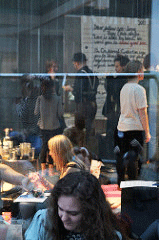So, what kind of neighbor are you?
When last did you take a true risk to establish a meaningful connection with someone with a very different background from yours?
“Be the change that you want to see” is a compelling and actionable mantra, but how many of us are stepping out of our comfort zones on a regular basis to engage and learn from others who are different from ourselves? It takes incredible effort to maintain intentionality in our regular interactions to make sure that we’re making the most of these opportunities.
After twelve years studying mixed-income developments around the country and establishing an applied research center to understand the possibilities and challenges of intentional integration across lines of income and race, it has been quite striking to realize that a core emerging challenge in these highly planned and carefully managed communities is also an existential challenge facing our broader national and global society. Can we achieve true integration of the most vulnerable and marginalized in our societies and avoid what Robert Chaskin and I have recently coined “incorporated exclusion,” where residential integration leads to more, not less, marginalization? Can we find ways to coexist as neighbors with people who are very different from ourselves in terms of race, ethnicity, class, norms of behavior and, most perhaps most cogently today, religious belief?
I have formulated three concepts from our mixed-income research that now seem quite timely and broadly applicable with implications for policy and practice as well as personal initiative: activating the mix, effective neighboring, and vigilant humanism.
Activating the Mix. Though many of our cities remain deeply segregated by income and race, there are an increasing number of planned mixed-income developments as well as more “naturally-occurring” gentrifying neighborhoods. These should be the bright spots in our quest for a more inclusive and equitable society. But instead, as Derek Hyra pointed out in a recent Shelterforce article, segregation endures within these mixed environments.
Clearly, residential integration alone is not sufficient, we must go a step further to “activate” the mix in these communities with intentional and proactive strategies to create spaces, activities and routines that facilitate positive and constructive relationships across income and race through which formerly marginalized individuals can connect with opportunities for economic and social mobility.
Effective neighboring. It is a term I use to describe a key element of activating the mix. Individuals in mixed-income communities are not necessarily looking for new friends or to have their neighbors intrude on their lives–but they do want to feel comfortable and welcome in their community, to know who their neighbors are and that they are watching out for their home and perhaps their kids, and to have a sense of common ground and shared expectations with those they live around. This “effective neighboring” takes deliberate and consistent effort, requires compromise and some willingness to step outside of your social comfort zone.
And finally, Vigilant Humanism. As social and tribal creatures, we have a deep instinct for categorizing all those we come into contact with as an “us” or a “them.” Humanism has a proliferation of meanings but the one I have in mind here is what the Oxford English Dictionary captures as a focus on “the inherent value and potential of human life.” Seeing others first as fellow human beings, rather than of a race, class, religion, or other social category. This is my toughest stretch personally and perhaps yours too. Vigilance is required because we must combat deeply ingrained instincts to label and prejudge. This will be a lifelong quest for each of us given all the forces that continually push in the direction of “us versus them” dynamics. As Robert Putnam’s research demonstrated, the more diverse our community, the more we tend to “hunker down” from those different from us.
In a recent New York Times column, David Brooks asserts that “the primary task before us [is] to repair the social fabric–the basic respect diverse Americans have for one another.” I think this is precisely the pathway to the inclusive, socially-sustainable future that many of us aspire to: 1) bottom-up vigilant engagement across difference, 2) personal learning and stretching from that engagement, 3) thinking, acting, reacting, and voting differently based on that learning and stretching. The key personal shifts in that process are confronting and updating our prejudices, gaining deeper empathy, and changing the narratives in our heads about the “other.”
Enlightened, socially-galvanizing actions by our leaders and representatives are crucial, and sadly few and far between these days, but ultimately, it is the engagement decisions, day in and day out, made by each of us in our personal lives that will determine the path forward for our society.
This means we can each do our part. Now. Are you up for a little vigilant humanism?
Photo credit: craftivist collective, via Flickr, CC BY 2.0)





This is a great piece, and calls out the responsibility we all have in breaking down the status quo of exclusion, and beginning to create real and meaningful connections with people you may not traditionally have known otherwise. Being a good neighbor means being a good citizen, and engaging in the lives of our neighbors, both those living across the driveway and those that live “on the other side of the tracks.”
Mark:
Your terms of engagement are compelling.
The community land trust movement often finds itself serving as the Steward of inclusionary units required by development law.
Your connection to this movement would make a lot of sense as one way to implement your thoughts on “Activating the Mix, Effective Neighboring and Vigilant Humanism.”
Richard Lawrence
San Diego Community Land Trust
Western Institute for Social Research